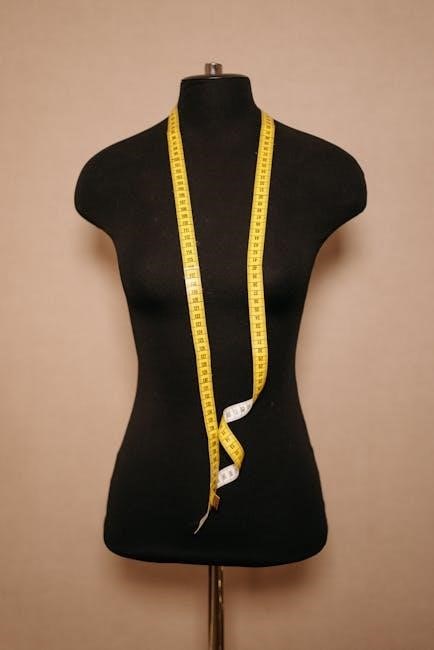Overview of the AIA A305 Form
The AIA A305 form is a standardized document for evaluating contractors’ qualifications and financial stability‚ essential for project owners to assess past performance and capabilities effectively.
1.1 Definition and Purpose
The AIA A305 form is a standardized document used to evaluate contractors’ qualifications and financial stability. It provides a comprehensive format for contractors to present their experience‚ capabilities‚ and financial standing to project owners. The form serves as a sworn‚ notarized statement‚ ensuring transparency and compliance with industry standards. Its primary purpose is to help project owners assess potential contractors’ reliability and suitability for construction projects effectively.
1;2 Importance in the Construction Industry
The AIA A305 form plays a crucial role in the construction industry by providing a standardized method for evaluating contractors’ qualifications and financial stability. It ensures transparency and fairness in the selection process‚ helping project owners make informed decisions. By assessing past performance and capabilities‚ the form minimizes risks and enhances project success‚ making it an essential tool for ensuring reliable contractor selection and compliance with industry standards.
Structure and Components of the AIA A305 Form
The AIA A305 form includes sections for company information‚ financial data‚ experience‚ and attachments‚ requiring a sworn‚ notarized statement to validate contractor qualifications and financial stability.
2.1 Sections and Subsections
The AIA A305 form is divided into clear sections‚ including company information‚ financial data‚ and project experience. Subsections detail specific requirements like revenue history‚ bonding capacity‚ and notable projects‚ ensuring comprehensive evaluation of a contractor’s qualifications and financial stability for project owners.
2.2 Required Information and Attachments
The AIA A305 form requires detailed financial statements‚ a sworn statement‚ and notarized documents. Attachments include exhibits elaborating on key aspects of the contractor’s qualifications‚ such as project experience and financial stability. These elements ensure project owners can thoroughly assess the contractor’s capabilities and reliability for the project at hand.

How to Complete the AIA A305 Form
Complete the AIA A305 form by providing a sworn‚ notarized statement and attaching required documents. Follow the step-by-step guide to ensure accuracy and compliance with requirements.
3.1 Step-by-Step Filling Guide
The AIA A305 form requires a sworn‚ notarized statement from contractors. Begin by filling in contractor information‚ financial data‚ and relevant experience. Attach required documents‚ such as exhibits‚ to support claims. Ensure all sections are completed accurately‚ and have the form notarized. Review for completeness and compliance before submission to project owners for evaluation.
3.2 Tips for Effective Completion
Start early to ensure thorough preparation. Use clear and concise language‚ avoiding ambiguities. Attach all required exhibits and supporting documents. Double-check financial data and project details for accuracy. Consider legal review to ensure compliance. Ensure the form is notarized and signed by authorized personnel. Submit well in advance of deadlines to avoid last-minute issues. Organize information logically for easy evaluation by project owners.

Legal and Confidentiality Considerations
The AIA A305 form requires a separate confidentiality agreement if sensitive information is to be protected. Legal implications ensure data handling complies with industry standards and regulations.
4.1 Confidentiality Agreements
A confidentiality agreement is essential when using the AIA A305 form to protect sensitive information. The form specifies that parties should execute a separate agreement if confidentiality is required. This ensures that all shared data‚ including financial details and project specifics‚ remain secure and are not disclosed without authorization. Breaches of such agreements can lead to legal consequences‚ emphasizing the importance of proper documentation and adherence to privacy protocols.
4.2 Legal Implications of the Form
The AIA A305 form holds significant legal implications as it is a sworn‚ notarized document. Contractors must provide accurate and truthful information‚ with any misrepresentation potentially leading to legal consequences. The form emphasizes the need for a separate confidentiality agreement to protect sensitive data. Additionally‚ it is protected by copyright‚ with all rights reserved by the American Institute of Architects‚ ensuring its proper and authorized use in construction projects.
Benefits of Using the AIA A305 Form
The AIA A305 form provides a standardized way for contractors to present qualifications and experience‚ helping project owners evaluate past performance and capabilities‚ enhancing credibility and bidding success.
5.1 Advantages for Contractors
The AIA A305 form allows contractors to showcase their qualifications‚ experience‚ and financial stability in a standardized format. This enhances credibility and trust with project owners‚ improving bidding success. By providing a clear and structured presentation‚ contractors can demonstrate their capabilities effectively‚ making it easier for owners to evaluate their suitability for projects. This transparency can lead to more opportunities and stronger client relationships.
5.2 Advantages for Project Owners
The AIA A305 form provides project owners with a standardized method to evaluate contractors’ qualifications‚ experience‚ and financial stability. This ensures informed decision-making and reduces risks. By reviewing a structured presentation of contractors’ capabilities‚ owners can efficiently assess suitability for projects‚ leading to better outcomes and increased confidence in selecting reliable contractors for successful project execution.

Common Mistakes to Avoid
Common errors include incomplete submissions‚ missing attachments‚ and inaccurate financial data. Ensuring all required information is provided and verified is crucial for a successful review process.
6.1 Errors in Submission
Common errors in submitting the AIA A305 form include incomplete or missing sections‚ inaccurate financial data‚ and failure to notarize statements. These oversights can delay the review process and may result in rejection. Ensuring all required fields are filled accurately and attachments are included is essential to avoid such issues and ensure a smooth evaluation of the contractor’s qualifications.
6.2 Omissions in Required Information
Omissions in the AIA A305 form often involve missing financial statements‚ incomplete project histories‚ or unsigned documents. These gaps can lead to delays or rejection‚ as evaluators rely on this data to assess a contractor’s suitability. Thoroughly reviewing each section and ensuring all required attachments are included is crucial to prevent such issues and ensure a comprehensive evaluation.

How to Obtain the AIA A305 Form
The AIA A305 form is available as a free PDF download from the official AIA website or authorized construction management platforms‚ ensuring easy access for professionals.
7.1 Downloading the PDF Version
The AIA A305 form can be downloaded as a PDF from the official AIA website or authorized construction management platforms. It is available for free‚ enabling easy access for contractors and project owners. The PDF version ensures compatibility with various devices and software‚ allowing users to fill it out digitally or print it for manual completion. This format maintains the form’s professional structure and clarity.
7.2 Sources for the Form
The AIA A305 form is available on the official AIA website and select construction management platforms. It can also be accessed through legal document repositories and architectural software providers. Ensure to download from authorized sources to guarantee authenticity and compliance with industry standards. Purchasing from trusted platforms prevents unauthorized modifications and ensures the document’s integrity for professional use.

The Role of the AIA A305 in Bidding Process
The AIA A305 form plays a crucial role in the bidding process by providing a standardized method to evaluate contractors’ qualifications and financial stability‚ ensuring informed decision-making for project owners.
8.1 Evaluating Contractor Qualifications
The AIA A305 form enables project owners to assess contractors’ qualifications by providing detailed information on their experience‚ financial stability‚ and past performance. This standardized document ensures a thorough evaluation‚ helping owners make informed decisions during the bidding process. By reviewing the form‚ owners can identify contractors who meet project requirements‚ ensuring reliability and competence. This step is crucial for selecting the right contractor.
8.2 Enhancing Bidding Success
The AIA A305 form plays a crucial role in enhancing bidding success by providing a standardized format for contractors to showcase their qualifications and experience. This ensures transparency and fairness in the bidding process‚ allowing project owners to evaluate bids more effectively. By clearly presenting their credentials‚ contractors can differentiate themselves‚ increasing their chances of securing projects. This form streamlines the selection process‚ benefiting both contractors and project owners.

Comparison with Other AIA Forms
The AIA A305 form is specifically designed for contractor qualifications‚ differing from other AIA forms that focus on construction contracts or payment applications‚ making it unique for evaluating contractor credibility and experience.
9.1 Similarities and Differences
The AIA A305 form shares structural similarities with other AIA forms but differs in purpose. While forms like AIA A312 focus on payment bonds and AIA A107 on contract conditions‚ the A305 specifically evaluates contractor qualifications and financial stability. Its unique structure emphasizes past performance and capabilities‚ distinguishing it from other AIA forms tailored for different construction processes and documentation needs.
9.2 When to Use AIA A305 Specifically
The AIA A305 form is specifically used when project owners need detailed evaluations of contractors’ qualifications‚ financial stability‚ and past performance. It is ideal for high-stakes projects requiring thorough assessments of a contractor’s capabilities. Use this form during the bidding process to ensure transparency and credibility‚ particularly when evaluating multiple contractors for large-scale or complex projects.
Case Studies and Practical Examples
The AIA A305 form has been successfully implemented in various construction projects to evaluate contractors’ qualifications and financial stability‚ ensuring transparency and credibility in the bidding process.
10.1 Successful Implementation in Projects
The AIA A305 form has proven instrumental in streamlining contractor evaluations for large-scale projects‚ ensuring transparency and accountability. Its structured format allows project owners to assess qualifications and financial stability effectively‚ fostering informed decision-making and successful project outcomes.
10.2 Lessons Learned from Real-World Applications
Real-world applications of the AIA A305 form highlight the importance of thorough preparation and attention to detail. Contractors often face delays due to incomplete submissions or lack of clarity in attachments. Ensuring all financial and experiential data is accurate and well-documented is crucial. Additionally‚ project owners should verify the form’s compliance with legal standards to avoid disputes and ensure smooth project execution.
Future Trends and Updates
The AIA A305 form is expected to undergo digitalization‚ enhancing efficiency and data management. Future updates will focus on streamlining processes and ensuring compliance with evolving industry standards.
11.1 Expected Revisions
The AIA A305 form is anticipated to undergo revisions to enhance clarity and compliance with industry standards. Updates may include streamlined processes for digital submissions and improved sections for financial disclosures. An Additions and Deletions Report will detail these changes‚ ensuring users are informed about modifications to the form’s structure and requirements.
11.2 Digitalization of the Form
The AIA A305 form is increasingly moving toward digitalization‚ with PDF versions available for easy downloading and editing. This shift enhances accessibility and streamlines the submission process. Digital tools‚ such as PDF editors‚ enable users to fill out and manage the form efficiently. Integration with construction management software further supports seamless data transfer and record-keeping‚ modernizing the documentation process for contractors and project owners.

Best Practices for Using the AIA A305
Best practices include using PDF editors for efficient digital management‚ ensuring accuracy in submissions‚ and maintaining strict confidentiality throughout the entire process.
12.1 Preparing for Submission
Thoroughly review the AIA A305 form to ensure all required information is accurate and complete. Organize attachments and exhibits to support the contractor’s qualifications and financial stability. Verify that all sections are filled out correctly‚ and ensure confidentiality agreements are in place if sensitive information is included. Double-check for any omissions or errors before finalizing the submission to avoid delays or rejections.
12.2 Maintaining Accuracy and Compliance
Maintaining accuracy and compliance is crucial when using the AIA A305 form. Ensure all information is truthful and verifiable‚ as the form often requires a sworn‚ notarized statement. Regularly review and update the document to reflect current financial standings and project experiences. Adhere to legal standards and confidentiality agreements to protect sensitive data and avoid potential disputes or penalties.

Tools and Software for Managing AIA A305
Utilize PDF editors and construction management software to efficiently manage the AIA A305 form‚ ensuring accurate data entry‚ secure storage‚ and compliance with industry standards.
13.1 PDF Editors and Form Fillers
PDF editors and form fillers are essential tools for managing the AIA A305 form. They allow users to fill‚ save‚ and print the form efficiently. These tools support converting the form into editable formats‚ ensuring accuracy and compliance. Popular options include Adobe Acrobat and online PDF editors‚ which streamline the process of completing and submitting the AIA A305 form digitally.
13.2 Integration with Construction Management Software
Integrating the AIA A305 form with construction management software enhances project workflows by streamlining data flow. This integration allows seamless sharing of contractor qualifications and financial details‚ reducing manual entry and errors. Software like Procore or Autodesk Construction Cloud can automatically update project records‚ ensuring real-time collaboration and compliance. This digital approach improves efficiency and accuracy throughout the construction process.

Industry Insights and Expert Opinions
Experts highlight the AIA A305 form as essential for evaluating contractor qualifications‚ ensuring transparency and compliance in construction projects. Architects and contractors recommend its use for thorough assessments.
14.1 Feedback from Contractors and Architects
Contractors and architects consistently praise the AIA A305 form for its comprehensive structure‚ which provides a clear and standardized way to present qualifications and financial stability. Many contractors appreciate how the form helps them showcase their experience and capabilities effectively‚ while architects value the transparency it brings to the evaluation process. This mutual benefit enhances credibility and trust in construction projects.
14.2 Expert Recommendations
Experts highly recommend using the AIA A305 form for its standardized and comprehensive approach to presenting contractor qualifications. They emphasize the importance of thorough preparation and accuracy to ensure compliance with industry standards. Proper use of the form can significantly enhance credibility and trust between contractors and project owners‚ making it a valuable tool in construction project management.
The AIA A305 form is a crucial tool in the construction industry‚ ensuring transparency and compliance. Its standardized approach streamlines contractor evaluations‚ fostering trust and accountability.
15.1 Summary of Key Points
The AIA A305 form is a standardized document for evaluating contractors’ qualifications‚ financial stability‚ and experience. It provides project owners with a clear framework to assess past performance and capabilities‚ ensuring transparency and compliance. Proper completion enhances bidding success and project confidence‚ making it an essential tool in the construction industry‚ supported by expert recommendations for effective use.
15.2 Final Recommendations for Users
Ensure accuracy and compliance by carefully reviewing the AIA A305 form before submission. Consult professionals for complex sections and stay updated on form revisions. Utilize digital tools for efficient management and maintain organized records. Adhere to confidentiality agreements and leverage the form to enhance credibility and bidding success in construction projects.
